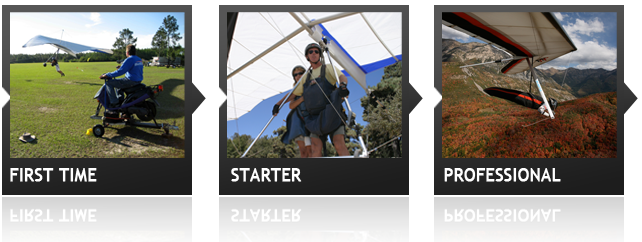The Sport

Click the buttons for more information.
History
Most early glider designs did not ensure safe flight; the problem was that early flight pioneers did not understand the underlying principles that made a bird's wing work. Starting in the 1880s technical and scientific advancements were made that led to the first truly practical gliders. Otto Lilienthal of Germany duplicated some of his contemporaries' work and greatly expanded on it from 1874. He rigorously documented his work, strongly influencing later designers; for this reason, Lilienthal is one of the best known and most influential early aviation pioneers. His type of aircraft is now known as a hang glider. In 1951 Francis Rogallo and Gertrude Rogallo applied for a patent for a fully flexible wing with approved claims for its stiffenings and gliding uses, the flexible wing or Rogallo wing, which in 1957 the American space agency NASA began testing in various flexible and semi-rigid configurations in order to use it as a recovery system for the Gemini space capsules. The various stiffening formats and the wing's simplicity of design and ease of construction, along with its capability of slow flight and its gentle landing characteristics, did not go unnoticed by hang glider enthusiasts. In 1960-1962 Barry Hill Palmer adapted the flexible wing concept to make foot-launched hang gliders with four different control arrangements. In 1963 Mike Burns adapted the flexible wing to build a kite-hang glider he called Skiplane. In 1963, John W. Dickenson adapted the flexible wing airfoil concept to create the most popular hang glider format to date. For this, the Fédération Aéronautique Internationale vested Dickenson with the Hang Gliding Diploma (2006) for the invention of the modern hang glider.

Click the buttons for more information.
History
Most early glider designs did not ensure safe flight; the problem was that early flight pioneers did not understand the underlying principles that made a bird's wing work. Starting in the 1880s technical and scientific advancements were made that led to the first truly practical gliders. Otto Lilienthal of Germany duplicated some of his contemporaries' work and greatly expanded on it from 1874. He rigorously documented his work, strongly influencing later designers; for this reason, Lilienthal is one of the best known and most influential early aviation pioneers. His type of aircraft is now known as a hang glider. In 1951 Francis Rogallo and Gertrude Rogallo applied for a patent for a fully flexible wing with approved claims for its stiffenings and gliding uses, the flexible wing or Rogallo wing, which in 1957 the American space agency NASA began testing in various flexible and semi-rigid configurations in order to use it as a recovery system for the Gemini space capsules. The various stiffening formats and the wing's simplicity of design and ease of construction, along with its capability of slow flight and its gentle landing characteristics, did not go unnoticed by hang glider enthusiasts. In 1960-1962 Barry Hill Palmer adapted the flexible wing concept to make foot-launched hang gliders with four different control arrangements. In 1963 Mike Burns adapted the flexible wing to build a kite-hang glider he called Skiplane. In 1963, John W. Dickenson adapted the flexible wing airfoil concept to create the most popular hang glider format to date. For this, the Fédération Aéronautique Internationale vested Dickenson with the Hang Gliding Diploma (2006) for the invention of the modern hang glider.